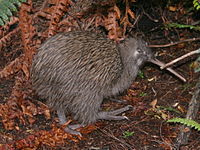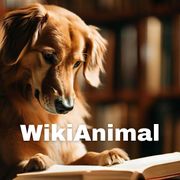Main Page
Featured article

Tokoeka are the largest of the kiwi, with males weighing up to 3.3 kg and females up to 4.2 kg. They have soft, brown feathers streaked with black and reddish brown, long pale bills, short legs and toes, and no tail. They are nocturnal, except on Stewart Island where they sometimes forage during the day. They have a keen sense of smell and use their bills to probe the ground for invertebrates, such as worms, beetles, cicadas and moths. They also eat some fallen fruit and leaves.
Tokoeka have distinctive calls that they use to communicate with their mates and to mark their territories. The male gives a high-pitched ascending whistle repeated 15-25 times, while the female gives a lower-pitched hoarse cry repeated 10-20 times.
Featured interview

Wildlands Network's Chief Scientist, Ron Sutherland, discusses the importance of rewilding efforts and their vision of continental wildways.
Wildlands Network's Chief Scientist, Ron Sutherland, discusses the importance of rewilding efforts and their vision of continental wildways to promote wildlife conservation in North America. Rewilding, a concept rooted in letting nature reclaim its territory, emphasizes the need to reintroduce keystone species to restore ecological balance. Ron explains how rewilding helps to manage ecosystems more efficiently and highlights the case of Yellowstone's wolf reintroduction, which led to a cascade of positive ecological effects.
Featured blog

In a study posted last year, it was found that trophy hunters killed one animal every THREE minutes over the last decade.
The Intergovernmental Panel on Climate Change (IPCC) has reported we have a decade left to help turn back the clock on preventing even larger scale climate disasters and rewilding of endangered species like the elephant and wolf can help promote healthier ecosystems which results in a healthier planet for you and me.
In the news
This weeks events
- 6 - 10 Nov: 77th CITES Standing Committee
- WikiAnimal Hub Events Calendar
Did you know?

- The great white shark can have up to 300 teeth at anyone time arranged in 7 rows in its mouth.
- The lemon shark gives birth to live young. Babies swim away quickly to avoid being eaten.
- Fish make up almost half of all vertebrates.
- When a hag fish feels threatened it releases slime from pores making it difficult to catch.
- The sailfish can swim at speeds up to 110 km/h (68 mph).
About WikiAnimal

WikiAnimal is an online knowledge base dedicated to the animal kingdom. Its mission is to offer a comprehensive and accessible resource for animal enthusiasts. Here you can find information about all kinds of animals, from mammals to reptiles, from birds to fish, from insects to amphibians. You can learn about their habitats, behaviors, diets, adaptations, conservation status and more.
You can also contribute to WikiAnimal by editing existing articles or creating new ones. Wikianimal is a collaborative project that relies on people like you to share their knowledge and passion for animals.
Join the growing WikiAnimal community in promoting knowledge, understanding, and compassion for animals.
WikiAnimal - founded Apr 10, 2023.WikiAnimal Projects
- Project Animal Talk - feature interviews and blogs from people who are passionate about animals.
- Project Newshound - Newshound is a Really Simple Syndication (RSS) retrieval platform that aggregates animal related content from various sources using RSS feeds. You can then access Newshound in a centralized location to view and stay updated on news and articles from different websites. Newshound algorithms attempt to ensure that you receive timely updates while trying to avoid overwhelming you with irrelevant information.
- Project Species - an ambitious initiative dedicated to documenting the vast diversity of life on Earth. Our mission is to create an exhaustive and comprehensive repository of knowledge about every (as many!) species of animal that inhabits our planet.
